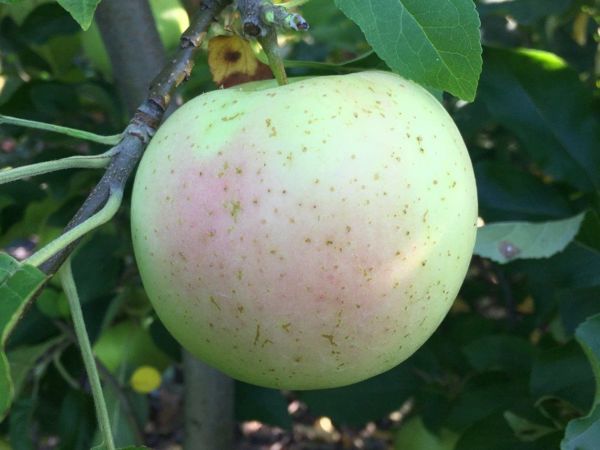An attractive, highly disease-resistant apple, ideal for organic growers.
White Winter Pearmain Apple on G.935 (Spring 2024)
An highly flavored heirloom apple suitable for mild-winter climates. Also known as White Pearmain, White Pearmain of Indiana.
This tree is vigorous, precocious, and productive, and it has an upright-spreading habit. It will need thinning to maintain annual bearing. Its most interesting feature from a horticultural perspective is the low chill requirement of 400 hours. This means that White Winter Pearmain can be successfully cultivated in warm-winter climates such as southern California.
The apple varies in size, from smallish to large, and its shape is somewhat irregular, usually conic. The smooth waxen skin is a translucent yellow, almost ghostly, with a small crown of russet around the stem. The creamy flesh is firm and finely textured with an aromatic flavor that is honeyed and tropical. An early North Carolina nurseryman said that White Winter Pearmain was regarded by leading pomologists in his state as "the highest flavored apple in cultivation." The fruit will store well for up to four months.
The origins of this variety are quite obscure. In the mid 1800s, a collection of scion wood was transported to Indiana by saddlebag. Two of these sticks had lost their labels (the nursery nightmare!), and both eventually produced apples that the grower, a Mr. Todd, named Red Pearmain and White Pearmain. The "Red Pearmain" was later identified as Esopus Spitzenburg, but the White Pearmain has never been identified. By the late 1800s it had become a favorite apple in the southern and midwestern states.
Even the name of this apple is a bit mysterious. The title "pearmain" has, like "pippin" been applied to many varieties over time, and nobody today knows exactly what the word originally meant. A very likely etymology, however, is that it derives from Old French parmaindre "to endure" with reference to an apple's storage potential.
The Fruit
Fruit Type
Category: Apple
Subcategory:
Heirloom, Hot-Climate
Fruit Uses & Storage
Uses: fresh eating, storage
Storage duration: three plus months (approximate, depending on storage conditions)
Fruit Appearance
Skin color: yellow
Flesh color: cream
Fruit Origins
Parentage: unknown
Origin: Indiana
Introduced in: 1800s
Introduced by: Mr. Todd
The Environment
Calendar & Geography
USDA zones: 5 - 8
Chill hours: 400
Ripening date: Sep 29 (approximate, in New York State) + 14 days after McIntosh
Tree Height & Spacing
glossary
Rootstock: G.935 Rootstock
Rootstock size class: Semi-Dwarf (40% of Standard)
Tree spacing (natural spread of tree): 12'
Good for wildlife planting? N
Diseases & Pests
glossary
White Winter Pearmain Apple on G.935 does not have any diseases or pests associated with it at this time.
Pollination
Pollination Factors
glossary
Bloom group: 3
Is it self-fertile? N
Is it fertile? Y
Ploidy: Diploid
Rootstock size class:
Semi-Dwarf (40% of Standard)
Pollination Partners
This table shows the first few results from a full search for pollenizers of White Winter Pearmain Apple on G.935. Please see our Pollenizer Search to run other queries and read how the application uses various factors. Also read more about fruit tree pollination.
See all pollination matches for White Winter Pearmain Apple on G.935
Featured Products
A few things we're loving right now...
A full-flavored, freestone white peach.
One of America's oldest apples, good for storage, baking, and cider.
A widely-grown, large, yellow-fleshed nectarine.




















